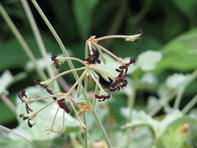A small, perennial herb with tuberous roots, Pelargonium sidoides common names include black pelargonium, ‘kalwerbossie’ and ‘rooi rabas’ (Afrikaans) rabassamin and ‘umckaloabo’ (isiZulu).

Benefits of Pelargonium Sidoides
Pelargonium sidoides has been shown to safely and effectively treat acute upper respiratory tract infections such as bronchitis, tonsillopharyngitis, sinusitis and the common cold. P. sidoides was first marketed by Charles Henry Stevens in Britain in 1897 as a treatment for TB.
Pelargonium sidoides was known as “Stevens’ Cure” but fell out of favour after the development of ‘chemical’ antibiotics. Yet, various studies have since confirmed P. sidoides’ antibacterial action. It can also be used for the treatment of infections such as cough, fever, sore throat, as well as fatigue and weakness.
Infusions of the tuber are used to treat dysentery and diarrhoea. Ethanolic extracts are used in a proprietary herbal tincture known as Umkaloabo. Infusions or decoctions are traditionally used. The plant is customary used by Zulu people to treat gonorrhoea, diarrhoea and dysentery.